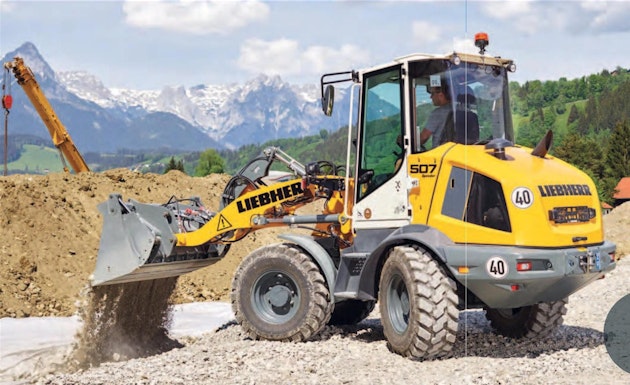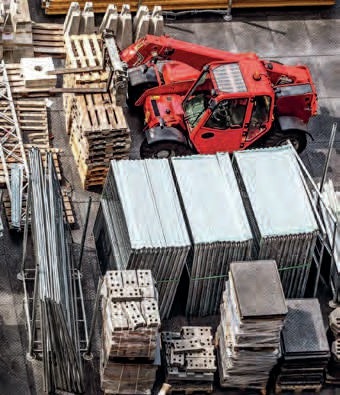7 mins
ROUND UP
IN CASE YOU MISSED IT
TOP HIGHLIGHTS
The Liebherr group has announced that revenues in the earthmoving, material handling technology, deep foundation machines, mobile and crawler cranes, tower cranes, concrete technology and mining product segments were 17% higher than in the previous year at just over €8 billion (US$8.8 billion).
> AUSTRALIA The Australian Rail Track Corporation (ARTC) has appointed Regionerate Rail as the preferred bidder for the development of the Gowrie to Kagaru section of Inland Rail in Queensland, Australia. The contract is worth more than AUD$5 billion (US$3.6 billion) for the design and construction – US$1.4 billion is attributable to Webuild.
Sales in earthmoving equipment were €2.3billion (US$2.5 billion), a 15% increase from last year, while sales for mining were up 18.9% at €1.1 billion (US$1.2 billion). Sales for material handling technology saw a rise of 16.1% to €554 million (US$608 million).
Pietro Salini, Webuild CEO, said, “For us, Australia is one of the most strategic markets in the world, given the opportunities that it offers in sustainable mobility and renewable energy.”
Both tower cranes and mobile and crawler cranes also saw increases in sales, of 26.8% and 14.9% respectively.
> ALBANIA Albania is preparing for the construction of a large dam on the Drin River with the intention of boosting its energy security. At an estimated cost of around €500 million (US$543 million), the proposed 210MW Skavica hydroelectric plant is expected to produce 20% of Albania’s domestic energy production, following a five-year construction period.
Sales increased in the EU, which has traditionally been the Group’s strongest sales region. High growth rates were recorded in almost all EU markets, with France in particular showing above average development.
Skavica will also optimise energy production at other dams, which currently supply 1,350MW of electricity.
Positive development was also seen in the Americas, where strong growth came especially from Brazil. Liebherr faced declines in Africa, as well as in the Middle East, whereas the financial year in Asia and Oceania ended with a moderate rise.
> GLOBAL The World Green Building Council (WorldGBC) has launched a framework that it says will help communities build with a holistic, inclusive and resilient approach to reconstruction in regions experiencing natural disasters and conflict, especially across the Southern and Eastern Mediterranean.
Liebherr noted that, regarding alternative drive technologies it takes a ‘technology neutral’ approach and in 2021 worked on hydrogen-powered combustion engines and their injection technologies, as well as electric drives.
The ‘Sustainable Reconstruction and Recovery Framework’ is structured around six themes which emphasise that disaster risk reduction, and the sustainable urban reconstruction of the physical environment, can restore the wellbeing of communities, revitalise livelihoods, and support social and cultural life.
In its annual report Liebherr said that it ‘started 2022 with a very good order situation’ but added that negative effects due to the war in Ukraine can already be seen. The company added that challenges with increasing prices for goods and materials, as well as their lack of availability remain, as well as the labour shortage.
> ITALY Case Construction Equipment has announced the launch of its new E-Series crawler excavator range – with seven new models from 13 to 30 tonnes. The new excavators will feature an enhanced cab design and operator experience in addition to improved hydraulic controls and settings, Case said.
The E-Series will incorporate Stage V engines in all seven models. The new FPT Stage V engines are designed to offer flexible fuelling solutions, and all E-Series models can be run on regular or alternative fuels, including hydrogenated vegetable oils.

Visit
www.khl.comfor your daily fix of all construction related news
IN CASE YOU MISSED IT
The Liebherr group has announced that revenues in the earthmoving, material handling technology, deep foundation machines, mobile and crawler cranes, tower cranes, concrete technology and mining product segments were 17% higher than in the previous year at just over €8 billion (US$8.8 billion).
Sales in earthmoving equipment were €2.3billion (US$2.5 billion), a 15% increase from last year, while sales for mining were up 18.9% at €1.1 billion (US$1.2 billion). Sales for material handling technology saw a rise of 16.1% to €554 million (US$608 million).
Both tower cranes and mobile and crawler cranes also saw increases in sales, of 26.8% and 14.9% respectively.
Sales increased in the EU, which has traditionally been the Group’s strongest sales region. High growth rates were recorded in almost all EU markets, with France in particular showing above average development.
Positive development was also seen in the Americas, where strong growth came especially from Brazil. Liebherr faced declines in Africa, as well as in the Middle East, whereas the financial year in Asia and Oceania ended with a moderate rise.
Liebherr noted that, regarding alternative drive technologies it takes a ‘technology neutral’ approach and in 2021 worked on hydrogen-powered combustion engines and their injection technologies, as well as electric drives.
In its annual report Liebherr said that it ‘started 2022 with a very good order situation’ but added that negative effects due to the war in Ukraine can already be seen. The company added that challenges with increasing prices for goods and materials, as well as their lack of availability remain, as well as the labour shortage.

PRICE RISES WHAT HAPPENED?
Construction is facing serious price rises, both for raw materials and energy. By the end of 2020 higher commodity prices had started to lead to increased prices for manufactured goods, with the price of steel in some parts of Europe rising by as much as 25%. The cost of lumber, according to figures reported in Fortune, skyrocketed 134% year over year.
In the short-term, prices are likely to increase, until the capacity of supply chains is fully restored. The resulting temporary material shortages might also cause delays to ongoing projects. Russia’s invasion of Ukraine has added to issues with supply chains and availability of raw materials.
According to Reuters, prices for wholesale natural gas have surged to record levels, reaching more than €120 (US$130) per megawatt hour at the start of April, up from €19.2 (US$20.90) a year earlier.
Oil prices have also risen sharply since the pandemic, with the price of Brent crude jumping from US$24.64 a barrel in April 2020 to US$105.25 a barrel in April 2022. And futures for thermal coal – the sort used in power stations – soared to US$281 a tonne in April 2022, up from US$49.28 in 2020.
“Energy costs make up approximately 30% of construction materials costs,” said Agnieszka Krzyzaniak, global research manager at design and engineering firm Arcadis.
WHAT IT MEANS
The cost of projects is going to rise. The latest International Construction Costs report revealed the top ten most costly cities to build in, with the report stating that due to rising energy costs, materials shortages and labour availability many major cities recorded double-digit cost increases.
Although sanctions imposed by Western governments on Russia following its invasion of Ukraine do not include natural resources, most Western trading partners have stopped doing business with the country. They are searching for alternative suppliers from other countries, increasing demand in a market when supply was already limited.

Materials are increasingly expensive to produce and buy
WHAT’S NEXT?
Price increases all round. According to the European Commission construction survey, a net balance of 45% of contractors surveyed in March reported that they expected to increase output prices – the highest number recorded since the start of the century.
Mace Group is forecasting that contractors will increase tender prices by 5.5% in 2022 after a record jump of 7.5% in 2021, primarily driven by rising materials costs. “Construction orders look strong as we go through the first quarter of 2022. However, this growth is likely to be tempered by geopolitical factors driving rising oil and gas prices,” said Matt Fitzgerald, commercial director at Mace Cost Consultancy.
DATA IS KING
Meta, parent company of Facebook, has launched two new data centre projects in Texas and Missouri, US, for a combined cost of approximately US$1.6 billion.
The Texas data center will be the company’s 21st data center worldwide, with 17 of those in the US. Facebook’s total investment in US data centre construction and operations is estimated at approximately US$16 billion.
The building of data centres is one of the biggest trends in construction. A report last year by Insight Partners valued the international data centre construction market at US$43 billion and predicted that it would rise to US$92 billion by 2025.

Data centre
construction is a growing trend
CALL TO END TARIFFS
Construction employment and spending on projects increased again in the US, but growth may stall unless tariffs on materials are lifted.
According to analysis of government data by the Associated General Contractors of America (AGC) construction employment climbed by 19,000 jobs between February and March, while spending on projects rose for the 12th month in a row.
However, the AGC said the industry will need to obtain materials on a more timely basis and hire hundreds of thousands of additional workers in order to execute projects that will soon be funded by the US$1.2 trillion Infrastructure bill, on top of existing demand.
MATERIAL COST OF WAR
The cost of direct damage to Ukraine’s infrastructure since Russia invaded has reached US$63 billion, according to analysis from the Kyiv School of Economics (KSE).
According to KSE, between the start of the invasion on February 24 through to March 24, at least 4,431 residential buildings, 92 factories and warehouses, 378 schools, 138 healthcare institutions, 12 airports and seven thermal power and hydroelectric power plants have been damaged, destroyed or seized.
In terms of infrastructure, the most expensive damage has occurred to roads – the cost is estimated at over US$27 billion. Damage to housing is estimated at US$13.5 billion.
UK TO GO NUCLEAR?
The UK government is reported to be planning a significant expansion of its nuclear energy capacity in a bid to decrease its energy dependence on fossil fuels. In an interview with The Telegraph newspaper, the UK’s business secretary, Kwasi Kwarteng, described the increasing need for the country to increase its energy self-reliance, saying, “there is a world where we have six or seven sites in the UK [by 2050]”.
Kwarteng’s interview followed an agreement within the government to establish a body (Great British Nuclear) with the power to expedite the process of identifying sites and offering contracts to build and run plants.